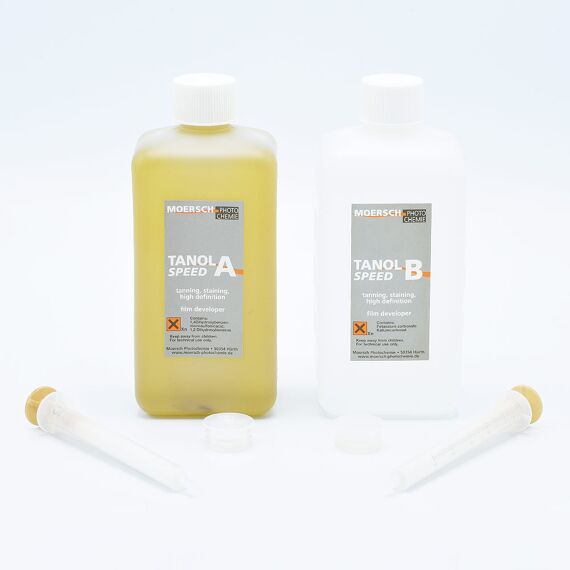- Available for all your questions
- Shopping at a Belgian family-run business
- Large selection, best prices
- Available for all your questions
- Shopping at a Belgian family-run business
Reviews (0)
Write the first reviewMoersch Photo Chemie
Moersch Tanol Speed 1000 Film Developer - (2x500ml)
Compared to Tanol, Tanol Speed efficiently yields higher film speeds and can offer shorter developing times. The stain will render yellow-greenish and the fog density can be higher than usual for some black-and-white films. Tanol Speed is most suitable for black-and-white films with a nominal film speed between ISO 25 and 400. The rated nominal film speed can be achieved, and even exceeded, for the majority of film types.
Tanol Speed can only be used with a selective number of films that are listed by Wolfgang Moersch in the data sheet of the developer. Unlisted films cannot be used with this film developer, but keep in mind than only the common brands have been tested and you can experiment with some unusual black-and-white films if wanted.
In the data sheet, developing times are given between 20°C and 24°C. Wolfgang Moersch recommends using a temperature of 24°C. After pre-watering at the same temperature, the developer may drop by 1 °C at most at room temperature of 20°C, even for times longer than 10 minutes.
The standard dilution for Tanol Speed is 1+1+100, but other dilutions are given in the data sheet for higher film speeds.
For T-Max films, a dilution of 1+1+130 gives a sensitivity gain of 1°DIN. With Rollei Superpan and Ilford FP4, doubling the nominal speed is possible by extending the development time. Unlike conventional push development by underexposure and overdevelopment, the curve is not split up, but is arched up from the shadows to the mid tones, so there is a real gain in sensitivity, without the blocking of highlights. For some films, however, the gain of up to one stop is associated with an increase in fog density.
This developer is not suitable for higher-sensitivity films such as Delta 3200. For films with a tendency to high base fog (Kodak Tri-X, Rollei Retro and Infrared), Finol is the better choice.
Capacity: 2x500ml makes 50-65 liters of working solution - 150-225 films.
| Concentrate type | Liquid |
Reviews (0)
Write the first reviewKeep me posted
Leave your email address. We will notify you as soon as this product is back in stock.
- Product: Moersch Tanol Speed 1000 Film Developer - (2x500ml)
- Size:

